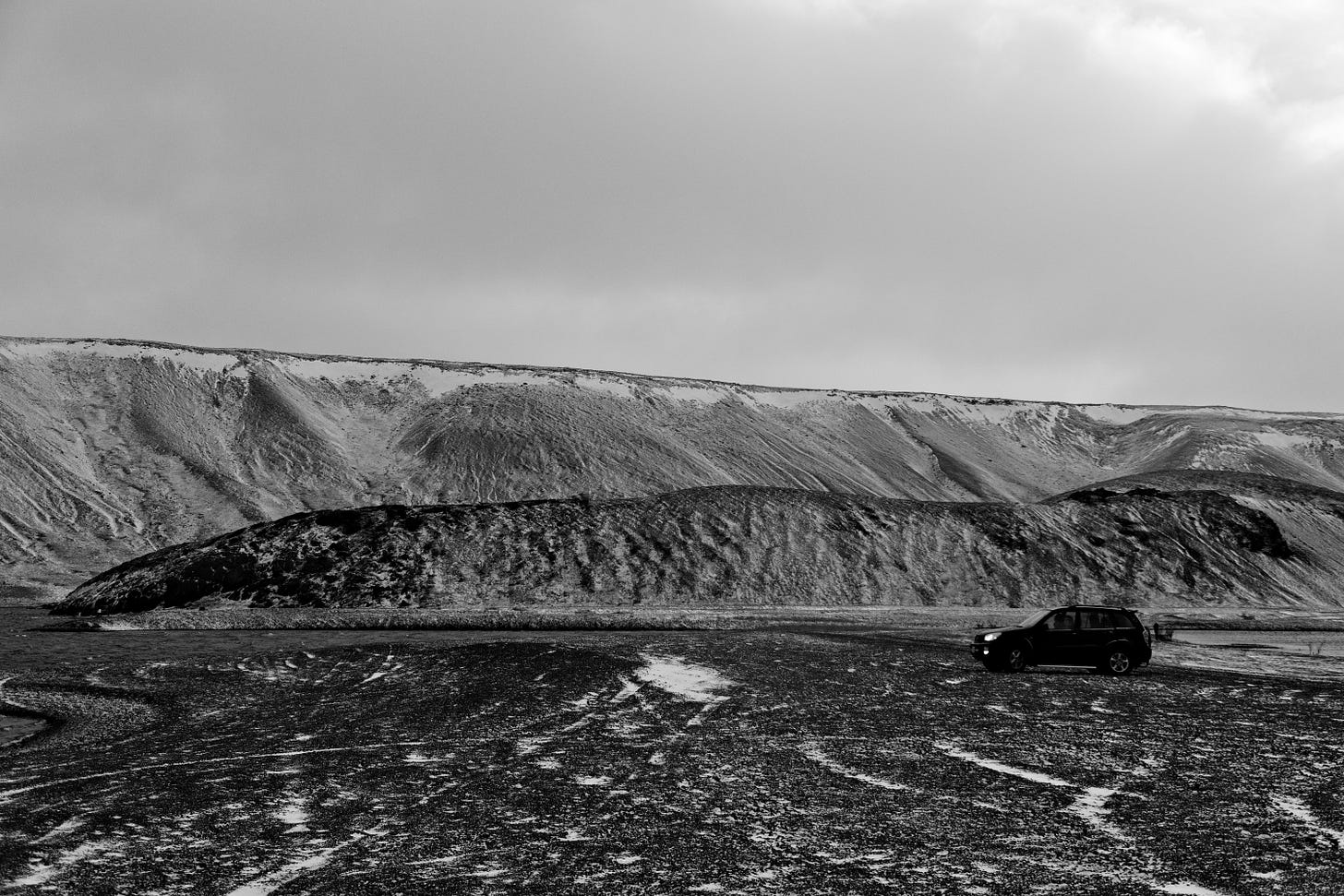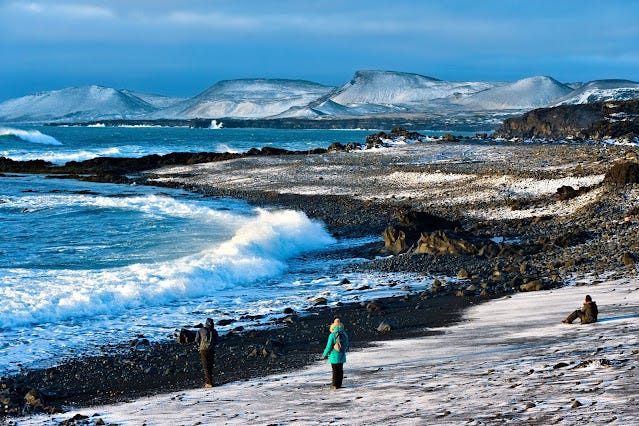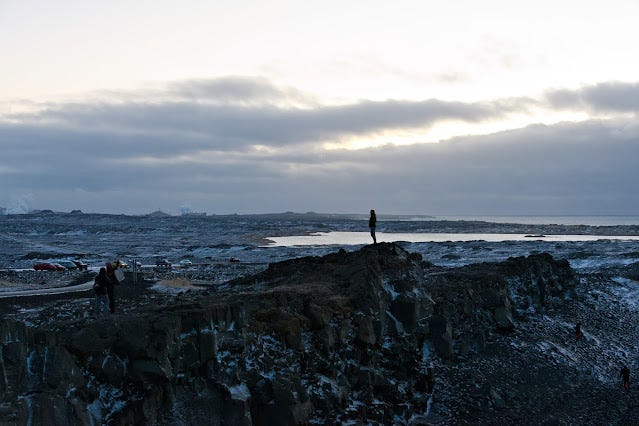Things to do in Iceland, Reykjanes peninsula
Sandvik, the bridge between the continents, Seltun Geothermal Area and more...
This is the third of four posts about my trip to Iceland, I spent there 10 days in December 2018. In this post, I will describe the Reykjanes peninsula, the region that comprehends Keflavik, where the airport is, and Reykjavik. This was the second of 3 excursions that I did during my trip, I already talked about the Golden Circle and I will speak about the South Coast with the black sand beach.
I participated in a volunteer work camp in Reykjavik and we celebrated New Year’s Eve there together with the other volunteers. I did some excursions to get to know the island, and the one to the Reykjanes peninsula is one of these. The volunteer organization offered us the opportunity to do these daily excursions paying a fee. We were leaving Reykjavik by car around 10 am and coming back at the latest at 5 pm.
Iceland is an amazing place, nature at its best, here is where I started to practice photography and since then I never stopped.
Iceland
Iceland, known as "The Land of Fire and Ice," is a captivating island nation located in the North Atlantic Ocean. It's renowned for its stunning natural beauty and unique geological features.
Iceland boasts a striking juxtaposition of active volcanoes and sprawling glaciers. With a population known for its warmth and resilience, Iceland has also preserved a rich cultural heritage steeped in ancient sagas and modern creativity. From cascading waterfalls to vibrant cities, Iceland offers an unparalleled blend of natural wonders and vibrant culture that mesmerized me and for sure all the people who visit it.
Reykjanes peninsula
The Reykjanes Peninsula is a rugged and geologically active region located in southwestern Iceland. It is a place of dramatic landscapes, characterized by volcanic craters, lava fields, geothermal areas, and a stunning coastline.
One of the most renowned attractions in Reykjanes is the Blue Lagoon, a geothermal spa surrounded by a surreal landscape of moss-covered lava fields. The milky-blue waters, rich in minerals, offer a rejuvenating experience like no other.
In addition to its geological wonders, Reykjanes is also steeped in history. The charming fishing village of Grindavík and the historic town of Reykjanesbær provide a glimpse into Iceland's maritime heritage, while the hauntingly beautiful “Bridge Between Continents” reminds us of the tectonic forces that shape the planet.
Kleifarvatn lake
The first stop of our tour was at this lake, it was a sunny day but with a strong cold wind. This mysterious lake is surrounded by rugged volcanic terrain and is the largest on the peninsula, covering an area of approximately 8 square kilometres.
What sets Kleifarvatn apart is its enigmatic allure. Deep, dark waters reflect the stark contrasts of the surrounding blackened lava fields, creating an atmosphere that is both haunting and captivating. The lake is renowned for its depth, plunging to over 97 meters in some places, making it one of Iceland's deepest.
Kleifarvatn is not only a visual spectacle but also a geological wonder. It sits atop a seismically active region, with occasional earthquakes causing fluctuations in its water levels. In 2000, a significant earthquake altered the lake's size, further emphasizing its dynamic connection to the Earth's subterranean forces.
A sense of tranquillity permeates the shores of Kleifarvatn, making it a popular spot for contemplation and leisurely walks.
When I arrived I felt as if I was in a place that I had never seen before: the mix of colours and the silence gave me the feeling I was on another planet. The sunrise gave the pictures unique colours and coloured also the lake, and I felt grateful to be there to witness it.
Indjánahöfði
The second stop was at Indjánahöfði, which is a prominent headland on the Kleifarvatn Lake, an ideal spot for landscape photography. Visitors to Indjánahöfði are treated to a panoramic spectacle of the lake, and all the volcanic mountains that surrounded it.
Indjánahöfði possesses a commanding presence over the Kleifarvatn Lake. Its name, translating to "Indian's Headland," carries a touch of mystique, hinting at a history intertwined with the lake.
As you can imagine, and as you can see in the pictures, in this place you can easily take beautiful pictures because the place itself is amazing. Even though this is not my favourite type of photography, I think that in this place you simply click because the photo is already there.
Seltun Geothermal Area
Seltún Geothermal Area is a mesmerizing display of Iceland's geothermal might. Steaming vents, vibrant mineral deposits, and bubbling mud pots punctuate the landscape, creating an otherworldly atmosphere that seems plucked from the pages of a fantasy novel.
As you wander through Seltún, the air is laced with the distinct scent of sulfur, a testament to the active volcanic forces beneath the Earth's surface. The ground, alive with hissing steam and boiling water, serves as a vivid reminder of the island's fiery heart.
In summer the palette of colours is a masterpiece in itself, with vivid yellows, fiery oranges, and rusty reds painting the earth. The contrast between the stark, grey rocks and the vibrant mineral deposits creates a surreal and captivating visual feast.
During winter everything is white and it is impressive anyway. Wild nature is all covered with snow and at the horizon maybe sometimes a building, a house, clouds or the sky.
Selatangar
After the geothermal area we went to Selatangar, which is a historically significant site, that bears witness to Iceland's maritime history and the resilience of its early settlers. This ancient fishing outpost, perched amidst rocky cliffs and battered by the North Atlantic winds, stands as a testament to the tenacity of those who called it home.
The remains of stone huts, once the shelter of hardworking fishermen, still cling to the shore, weathered by centuries of storms and elemental forces. These haunting ruins offer a poignant glimpse into the harsh realities faced by those who eked out a living from the unforgiving sea.
The ocean in winter impressed me, It was really cold because the wind was strong, but I loved it immediately and I didn't want to leave it. The atmosphere is one of quiet contemplation, where the sound of crashing waves mingles with the whispering winds. The dramatic coastal scenery, with its towering cliffs and sweeping views of the Atlantic, paints a picture of both solitude and grandeur.
Visiting Selatangar is akin to stepping back in time, to an era when survival depended on the skill and fortitude of those who dared to harness the bounty of the ocean. It is a place where history and nature converge, offering a poignant reminder of the indomitable spirit that shaped Iceland's coastal communities.
Reykjanesviti
Reykjanesviti is Iceland's oldest and most iconic lighthouse. Its stark white form stands in contrast to the rugged volcanic terrain, a sentinel overlooking the meeting of the Atlantic Ocean and the North Atlantic Drift.
First lit in 1878, Reykjanesviti has guided countless ships safely through Iceland's perilous coastal waters. The lighthouse itself is a testament to Icelandic craftsmanship, its elegant design a its harmonious blend of functionality and aesthetics.
This area includes not only the lighthouse but also a geothermal area that is at the next stop of the tour.
Reykjanesviti offers breathtaking views of the craggy coastline and the endless expanse of the Atlantic. I climbed one of the cliffs near the lighthouse on the way to take some pictures of the coastline and the landscape near the lighthouse.
Gunnuhver geothermal area
Gunnuhver is a powerful and visually stunning geothermal area, named after a legendary ghost, the area exudes an eerie and captivating aura.
Steaming vents and boiling mud pots create a mesmerizing display of nature's power, painting the landscape with vivid hues of orange, yellow, and red.
The legend of Gunnuhver adds a touch of mystique to this already captivating site. According to folklore, Gunna, a troublesome spirit, was bound to the area by a local pastor. Her restless spirit is said to have contributed to the geothermal activity, creating an atmospheric blend of folklore and geology.
The place has a surreal atmosphere; the colours, and the steam, are something that I have never seen before and are also difficult to find somewhere else. There is a route to follow to visit the area, and in some points, you can walk through the steam, even if some hot springs can reach 300°C.
This geothermal area has the largest mud pool, 20 meters wide of violently boiling earth. What makes Gunnuhver Hot Springs different from the others in Iceland is that the groundwater is seawater.
Sandvík
Sandvík is a picturesque coastal area, this idyllic stretch of shoreline, with its black volcanic sands and dramatic cliffs, offers a captivating vista of the North Atlantic Ocean.
This was our last stop of the tour, as you can see the sun was going down and the dark hours were coming. We went to see the bridge between continents, there is only one street that brings you there, and the landscape around there with that light was particular, it reminded me of a sort of dystopian movie.
The Bridge Between Continents is a representation of Iceland's unique geological position. This footbridge spans a fissure that marks the meeting point of the Eurasian and North American tectonic plates. As you step onto its sturdy surface, you're straddling two continents at once.
The Bridge Between Continents is more than just a physical structure; it's a symbol of Iceland's place in the world, straddling the divide between two major continental plates. It invites reflection on the immense geological forces that continue to shape our planet.
This excursion was the one that I liked the most of the 3 that I did because the weather was great and I was able to enjoy fully the day. Except for the Blue Lagoon, which I didn’t visit because it is too expensive to enter, the Reykjanes peninsula is not a main tourist attraction, so the places I visited were less crowded than the Golden Circle. I suggest you consider this region when you plan your travel to Iceland.
The next post will be the last one about Iceland, I will write about the excursion on the south coast, with the famous black sand beach and the Sólheimajökull glacier.






























Wow, your photos are AMAZING!!
The text is also great, covering so much detail for everyone interested. I spent a week on Reykjanes, but we visited only the highlights, so I'm saving your spots for a future visit, thank you!
I would love to go!